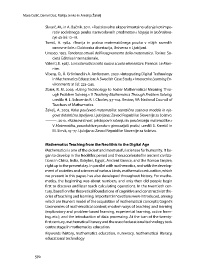Page 570 - Pedagoška vizija / A Pedagogical Vision
P. 570
Mara Cotič, Daniel Doz, Matija Jenko in Amalija Žakelj
Skvarč, M., in A. Bačnik. 2011. »Raziskovalno eksperimentalno učenje kot impe-
rativ sodobnega pouka naravoslovnih predmetov.« Vzgoja in izobraževa-
nje 43 (6): 12–18.
Tomić, A. 1984. »Teorija in praksa matematičnega pouka v nižjih razredih
osnovne šole.« Doktorska disertacija, Univerza v Ljubljani.
Unesco. 1972. Tendenze attuali dell’insegnamento della matematica. Torino: So-
cietà Editrice Internazionale.
Valenti, E. 1987. La matematica nella nuova scuola elementare. Firence: Le Mon-
nier.
Viberg, O., Å. Grönlund in A. Andersson. 2020. »Integrating Digital Technology
in Mathematics Education: A Swedish Case Study.« InteractiveLearning En-
vironments 31 (5): 223–243.
Zbiek, R. M. 2003. »Using Technology to Foster Mathematical Meaning Thro-
ugh Problem Solving.« V Teaching Mathematics Through Problem Solving,
uredilaH.L. Schoen inR.I.Charles,93–104. Reston,VA: National Councilof
Teachers of Mathematics.
Žakelj, A. 2003. Kako poučevati matematiko: teoretična zasnova modela in nje-
gova didaktična izpeljava. Ljubljana: Zavod Republike Slovenije za šolstvo.
———. 2010. »Raznovrstnost pristopov k učenju in poučevanju matematike.«
V Matematika, posodobitve pouka v gimnazijski praksi, uredili S. Kmetič in
M. Sirnik, 15–77. Ljubljana: Zavod Republike Slovenije za šolstvo.
Mathematics Teaching from the Neolithic to the Digital Age
Mathematics is one of the oldest and most useful sciences for humanity. It be-
gan to develop in the Neolithic period and then accelerated in ancient civiliza-
tions in China, India, Babylon, Egypt, Ancient Greece, and the Roman Empire,
rightuptothepresentday.Inparallelwithmathematics,andwiththedevelop-
ment of societies and sciences of various kinds, mathematics education, which
we present in this paper, has also developed throughout history. For mathe-
matics, the beginning was about numbers, and only then did people begin
first to discover and later teach calculating operations. In the twentieth cen-
tury, based on the theoretical foundations of cognitive and constructivist the-
oriesofteachingandlearning,importantinnovationswereintroduced,among
which are Bruner’smodel of the acquisition of mathematical concepts; Gagné’s
taxonomies of mathematical content; modern ways of teaching and learning
(exploratory and problem-based learning, experiential learning, active learn-
ing, etc.); and the introduction of data processing. At the turn of the twenty-
firstcentury,mathematicalliteracyandtheuseofeducationaltechnologytook
centre stage in mathematics education.
Keywords: history, mathematics education, numeracy, mathematical literacy,
educational technology
570

